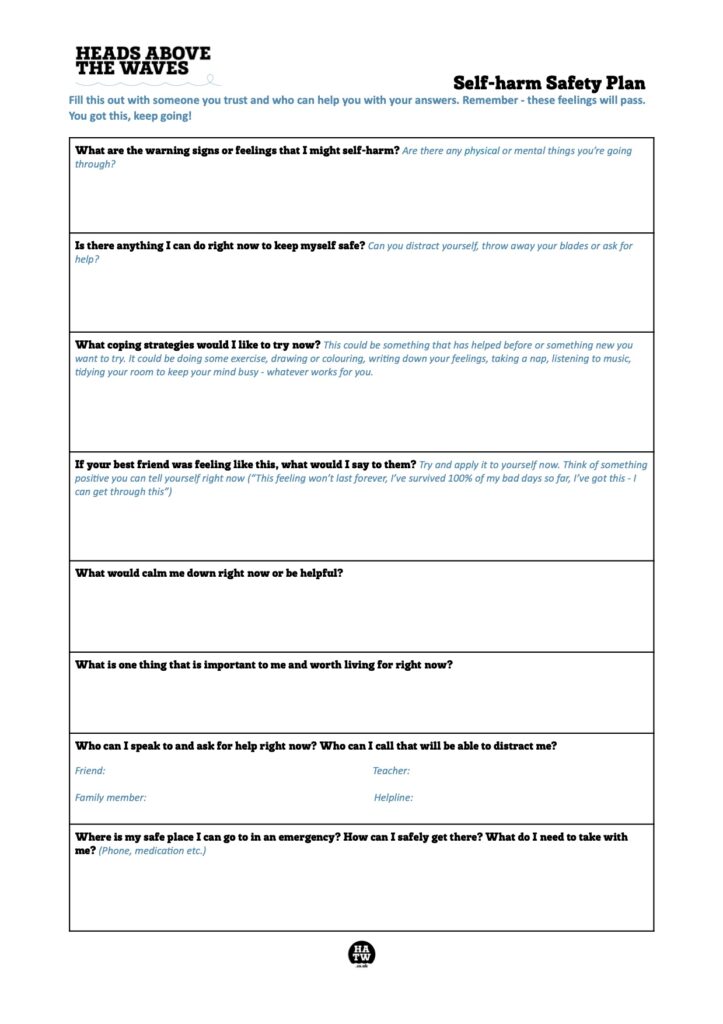Self-Harm Safety Plan
Today, we’re going to talk you through making a self-harm safety plan and share some pro tips, but remember — the key to making a plan work is making it work for YOU, because different things are gonna work for different people. Your plan will evolve from start to finish, but in the end, it’ll be tailored to fit you and your needs perfectly.
Why do I need a safety plan?
It’s important to remember that self-harm is a coping strategy, just like meditation or exercise — simply a way for people to cope with a bigger issue, release intense emotions, and ultimately find a way to move on with life in the face of severe turmoil. A self-harm safety plan can help protect you from harm when you’re feeling like a risk to yourself.
Understanding the connection between how you’re feeling — angry, sad, numb, anxious — and the coping strategies you use is key to creating a safety plan that works for you. When we use coping strategies based on what we feel in that moment, it can help those strategies work more efficiently, and helps us implement positive alternatives to self-harm.
What do you feel when you’re having a bad day?
You’ve likely heard us blather on about this in other posts, but we can’t over-emphasize how helpful it can be to keep track of how you feel both on the good days and the bad. When we consciously label our feelings, we can separate them out and understand them better, which allows us to help ourselves more efficiently.
In your self-harm safety plan you’ll include a list of coping strategies that you know work for you — but it’s helpful to realize that not every strategy fits every emotion. For example, colouring may really help when you’re anxious, as a way to keep your brain and hands occupied, but it may not be the right choice when you’re angry. You might want to try something a bit stronger in those instances — a cold shower, or screaming into a pillow, or punching something soft — to release that pent-up frustration and tension.
Every safety plan is different, and it’s all about what works for you. Now, it may take some troubleshooting before you really feel like you’ve got a handle on what works, and your safety plan will probably change over time. It’s important to remember that we’re all human, and we’re all just trying to figure out what helps us get through each day, so eventually we can have fewer bad days.
Something to try: When you start to recognise these nuances in your emotions, you can actively prepare for different scenarios in your safety plan. It might be helpful for you to see your coping strategies written out, with the different emotions written next to them, making it easier to decide what to do in the moment.

What do I put in my self-harm safety plan?
A safety plan is a document you put together to help you remember your options for support, coping strategies, and people and places you can trust if you’re feeling like you’re a risk to yourself. Things to include on your safety plan could be:
- Physical/mental warning signs you may not be in control of your feelings
- Positive coping strategies that work for you
- Positive affirmations, or alternatives to negative thoughts
- Who you can call for help if you’re in danger (friends, helplines, teachers…)
- Safe places you can go to or stay in an emergency, how to get there
- List of things you might need in an emergency: medications, your phone, or anything you need for your coping strategies
- What is the safest way to leave your house if you’re at risk and need to get somewhere safe?
- List of helplines you feel comfortable calling
- A reminder to call 999 if you’re in immediate danger, either to yourself or from someone else
There is no wrong way to make a plan, so long as you tailor it to your needs. Write it down, save it in your phone, and discuss it with someone you trust — this way, you’ll remember it when you need it most. Safety plans are unique to each individual, but they don’t have to be private — in fact, sharing your plan with people you trust can help keep you accountable, and can help the people around you understand what you’re going through and how to best help you.
Something to try: start your own self-harm safety plan by following this template. Once you feel like you’ve got a grasp on the purpose it should serve, you can personalise your plan to specifically fit your needs, and so you really connect to it and remember it.
Below, we’ve filled in our self-harm safety plan as an example of the sort of thing you could put on yours, but it’s important to remember that this plan is for you. There’s no right or wrong answers, and it’s going to be unique to you and your situation.
What are some coping strategies you could try?
Coping strategies are also unique to each individual, so it is super important to try different things until you find something that really clicks for you. For a massive list of coping strategies you can try, head on over to the Things To Try page on our website.
Here are a few coping strategies that could work when you’re feeling anxious, sad, or overwhelmed:
- Colouring, drawing, or writing to express emotions, keep the hands and mind occupied, and focus on the task at hand rather than external worries
- Journaling can help us work through complex emotions, vent about stress or frustration, and better understand ourselves
- Meditation, listening to music or podcasts can provide a calming, relaxed moment for the mind to switch off and just be a passenger, which is helpful when struggling with anxiety, but can also be uplifting when we’re sad (you can find tons of guided meditations on YouTube, or on apps like Headspace; Spotify is great for both podcasts and music)
- Cleaning something, like your room or the kitchen, can help you feel in control of something when everything else feels all jumbled up — and you know that they say: tidy room, tidy mind.
Here are some coping strategies that can help if you’re feeling angry, out of control, or frustrated:
- Running or walking fast can help release energy or tension in a positive way, almost like you’re putting distance between yourself and any negative emotions
- Taking a cold shower can help ‘cool’ you down when you feel like your emotions are bubbling over
- Screaming into a pillow is a super easy way to release tension almost immediately, because sometimes we just need to let it all out on those bad days
What phone numbers could you include?
For an extensive list of resources, click here, or find the ‘Help Me’ button in the top right corner of our website. Just like coping strategies are unique to the person, there are options for support that are unique to certain age groups and concerns.
-
- Samaritans are one of the UK’s biggest support systems, and provide around the clock mental health support for all ages.
- MEIC offers tailored support based on your age (up to 25), and offers no-judgement guidance for all issues, big and small.
- National Self-harm Network is an online forum that lets you talk with other people about all sorts of things in a safe, controlled environment. Members talk about the mechanisms that result in self-harm, and how to cope with it and related problems. There are members who self-harm, friends & family, and other support groups.
- Nightline is a nation-wide association based at universities, designed to help students who are struggling at uni, which can often feel isolated and lonely.
Talking about it makes it real, and also less scary
Discussing your safety plan with a trusted friend, teacher, counselor, parent, or GP can help it stick in your mind better, and can also help you feel less alone when dealing with these intense emotions. It’s important to talk about your plan not only when you’re feeling crummy, but also when you’re feeling good, so you remember the plan not as something negative, but as something that can help you get control of the situation so you can have fewer bad days in the long run. Just in the same way talking through your feelings out loud can help you rationalise them, talking about your feelings with people you trust can help you recognise the support system you have around you — this helps us better appreciate the people in our lives.
Remember!
Everyone around you is just trying their best to make it through each day, no matter their individual struggles, so there’s no reason to be ashamed about your own. Creating a plan, making it work for you, and sharing it with your friends and family is the first step to helping yourself implement more positive coping strategies, but keep in mind that nothing is perfect the first time around.
You may find that your plan goes through several different versions before you feel like it really works every time the way you need it to, but that’s okay! All that means is you’re getting to know yourself, paying attention to your physical and mental boundaries, and are putting in the work for yourself. And that’s a heck of a lot to be proud of!
You’re not alone, and you can do this — one step at a time.
If you found this post helpful, check out some more of our Straight Up Advice.
see more

